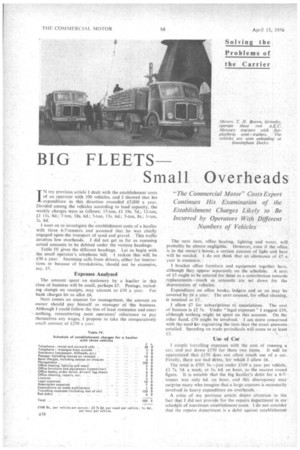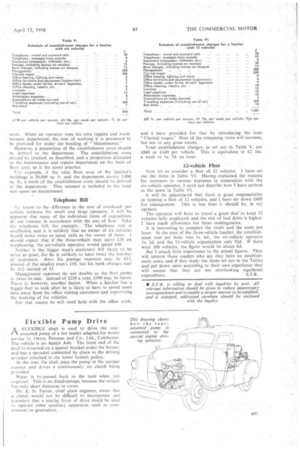BIG FLEETS Small Overheads
Page 72

Page 73

Page 75

If you've noticed an error in this article please click here to report it so we can fix it.
IN my previous article I dealt with the establishment costs of an operator with 100 vehicles, and 1 showed that his expenditure in this direction exceeded £5,000 a year. Divided among the vehicles according to load capacity, the weekly charges were as follows: 15-ton, £1 19s. 7d.; 12-ton, £1 I Is. 8d.; 7-ton, 18s. 6d.; 5-ton, 13s. 6d.; 3-ton, 8s.; 1-ton,
2s. 8d. , I went on to investigate the establishment costs of a haulier with three 6-7-tonners and assumed that he was chiefly engaged upon the transport of sand and gravel. This traffic involves low overheads. I did not get as far as assessing actual amounts to be debited under the various headings.
Table 1V gives the different headings. Let us begin with the small operator's telephone bill. I reckon this will be £30 a year. Incoming calls from drivers, either for instructions or because of breakdowns, should not be excessive, say, £5.
Expenses Analysed
The amount spent on stationery by a haatlier in this class of business will be small, perhaps £5. Postage, including stamps on receipts, may amount to £10 a year. For bank charges let us allot £6.
• Next comes an amount for management, the amount an owner should pay himself as manager of -the business. Although I could follow the line of least resistance and enter
\ nothing, remembering most operators' reluctance to pay themselves any wages, 1 propose to take the comparatively small amount of £250 a year. The next item, office heating, lighting and water, will probably be almost negligible. However, even if the office is in the owner's house, a certain amount of light and heat will be needed. I do not think that an allowance of £5 a year is excessive.
bracket office furniture and equipment together here, although they appear separately on the schedule. A sum of £5 ought to be entered for these as a contribution towards replacements—much as amounts are set down for the depreciation of vehicle's.
Expenditure on office books, ledgers and so on may be covered by £6 a year. The nextamount, for office cleaning, is nominal at ES.
I allow £7 for subscriptions tO associations. The cost of licences is £2 5s. Under legal expenses" I suggest £10, although nothing might be spent on this account. On the other hand, £50 might be involved. I am more concerned with the need for registering the item than the exact amounts entailed. Spending on trade periodicals will come to at least £3.
• Use of Car I couple travelling expenses with the cost of running a car, and put down £150 for these two items. It will be appreciated that £150 does not allow much use of a car. Finally, there are bad debts, for which I allow £6..
The total is £505 5s.—just under £169 a year per vehicle, £3 7s. 5d. a week, or Is. 6d. an hour, to the nearest round figure. It is notable that the big haulier's debit for a 6-7tonner was only 6d. an hour, and this discrepancy may surprise many who imagine that a large concern is necessarily involved in heavy expenditure on overheads.
A critic of my previous article draws attention to the fact that I did not provide for the repairs department in my schedule of maximum establishment costs. I do not consider that the repairs department is a debit against establishment
ROW IT WORKS. For easy control of acoldengine, a fast idling speed is a necessity.
For these conditions this type of starting device provides a ready
answer, and the principle used can be applied to both and zeroS arters already described, (see Adverts. 1 And 6).
The device is completely stable in operation, as the degree of enrichment is limited by calibrated orifices and not by the drivers control of linkage connecting a strangler and throttle butterfly, such a :; may he found on other carburettors.
In operation, the starter provides a progressively weaker mixture as the dashboard control is moved front the 'Intermediate.' to 'Full In' position. This manoeuvre adjusts the mixture strength to suit. a warming engine, obtains the idling speed required and when driving off, a slightly richer mixture for quick get away N.VhaSi the engine is nil cold.
111 the 'Intermediate' position, which is located by a spring loaded Each phase of its design automatically ensures the accurate supply of petrol and air required by differing engine demands, BUT you can't get the best out of your Solex if it is worn. Our pamphlet 'Your Carburetiorl explains why. iou're better off with a Solex because:— 11.0z.0 to obtain a current design Solex carburettor:— Complete the coupon and we will send you full details of our Reconditioned Service for Solex equipped vehicles, together with any published leaflet on the type we specify.
Our Exchange Service'offers a reconditioned Solex, guaranteed equal Sri new, for vehicles with a post-i935 Solex—the old carburettor being taken in part exchange. .
For vehicles with a pre-1936 Solcx or not at present Soles: equipped, raw carburettors are offered at an attractive price with an allowance for the old model when surrendered. this is tbe fourteenth of a series of:fourteen explanatory advertisements ((opies of the first thirteen are arailable on request)
ball under the starter lever (s1), the dished htile (H) in the valve (dd) is putt into circuit with the starter petrol jet (Gs). The orifice (H) (smaller than (cc), see Advert. 6) reduces fuel input from jet (Gs), and combined with air drawn into channel .(7) produces a weaker mixture,' •
Rotation of (rid) as the dashboard control is pushed honk progressively reduces the area of the outlet at (C) thus causing the engine to slow down, and the strength of the mixturc isadjusted to suit the new conditions as the engine warms_ up. When the , dashboard control is pushed 'Full In', the device is put out ---action by a blank face of (cid) coming opposite (0) and-(C).'
DRIVING AWAY—on opening the throttle (V) a cold engine,
extra enrichment is provided by suction then being brought directly in to the channel (Z), drawing mixture out from the starter box through (H). The degree of enrichment decreases to nothing as the disc valve (dd) is rotated from the 'Intermediate' to the 'Full In' position.
costs. When in operator runs his own repairs and maintenance department, the cost of working it is presumed to be provided for under the heading of "Maintenance." However, a proportion of the establishment costs should be debited to the department The establishment costs .should be totalled, as described, and a proportion allocated to the maintenance and repairs department on the basis of floor area, as is the usual practice.
• For example, if the total floor area of ehe haulier's buildings is 50,000 sq. ft. and the department covers 5.000 sq. ft., a tenth of the establishment costs should be debited to the department. That amount is included in the total sum spent on maintenance.
Telephone Bill o return to the difference in the cost of overheads per vehicle between the small and large operator, it will be apparent that many of the individual items of expenditure do not increase in accordance withthe size of fleet, Take the telephone bill, for example, . The telephone rent is unaffected, and it is unlikely 'that an owner of six vehicles would make twice as .many calls as the owner of three. I should expect that if the threer.vehicle man spent £30 on telephoning, the six-vehicle ,operator would spend £40.
Neither is the _bigger man's stationery bill likely to be twice as great, for he is unlikely to have twice the number of customers. —Also;' lis postage expenses may be £15, instead of the smaller man's £10, but his bank charges may
be £12 instead of £5 '
Management expenses do not double as the fleet grows to twice its size: Instead of £250 a year, £300 may be taken, There is, however, another factor. When a haulier has a bigger fleet to look after he is likely to. have to spend More time away from his 'office visiting customers and supervising the working of his vehicles.
For that reason he will need help with the office work.
Flexible Pump Drive
PAA FLEXIBLE, shaft is used todrive the rearmounted pump of a fire tender adapted for works service by Davey Paxman and Co., Ltd., Colchester. The vehicle is an Austin MO. The front end of the shaft is mounted on a speCial bracket under the bonnet and has a sprocket connected by chain to the driving sprocket attached to the lower fanbelt pulley.
At the rear, the shaft joins the pump in the normal manner and drives it continuously, no clutch being provided.
Water is by-passed back to the tank when not required. This is no disadvantage, because the vehicle has only short distances to cover.
Mr. E. N. Farrar, chief plant engineer, states that a clutch would not be difficult to incorporate and considers that a similar form of drive could be used to operate other auxiliary apparatus, such as compressors or generators. and 1 have provided for that by introducing the item "Clerical wages." Most of the remaining items will increase, but not to any great extent.. .
Total establishment charges, as set out in Table V. are £840 or £140 per vehicle. This is equivalent to £2 16s. a week or Is. '3d. an hour.
12-vehicle Fleet
Now let us consider a fleet of 12 vehicles. I have set out the items in Table VI. Having explained the reasons for increases in various expenses in connection with the six-vehicle operator, I need not describe how I have arrived at the sums in Table VI.
It will be appreciated that there is great responsibility in running a fleet of 12 vehicles, and I have set down £400 for management. This is less than it should be, in my opinion.
The operator will have to travel a good deal to keep 12 vehicles fully employed, and the risk of bad debts is higher. I have made allowance for these contingencies.
It is interesting to compare the totals and the costs per hour. In the case of the three-vehicle haulier, the establishment cost per hour was Is. 6c1., the six-vehicle operator Is.. 3d. and the 12-vehicle organization only 9-id. If there were 100 vehicles, the figure would be about 6d.
But I attach little importance to the aCtual figures. They will interest those readers who say they have no establishment, costs, and if they study the items set out in the Tables and put down sums according to their own experience they will ensure that they are not overlooking significant expenditure. S.T.R.




















































































































